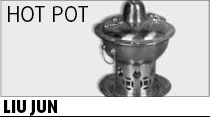Tomorrow we'll spend the afternoon making jiaozi dumplings. This has been our ritual for the Spring Festival Eve. It helps every family member vent troubles and share joys of the year, mince them in the stuffing and melt them into the fragrant steam.
Although there are machine-made jiaozi wrappers and minced meat, we like making them ourselves. My husband, who grew up in the southern city of Chaozhou, surprises me by making excellent wrappers.
In just a few minutes, he turns the dough into a winding snake, cuts it and rolls the pieces into palm-sized tenacious wrappers with a short pin.

Most people in the south eat special dishes and rice on the special day. But my husband learned from an old nanny who could "make double wrappers with two rolling pins at the same time", and she could finish making the stuffing, wrapping the dumplings and boiling them in less than one hour. The best jiaozi maker I've seen is my dad. In his hometown in Henan province, maize flour porridge and steamed bun remain the staple food. Jiaozi is reserved for the most important day of the year.
In Yunnan province, where our family lived for a decade, Dad made a square pine board just for dumplings, noodles and other pastries. My sister and I longed for Spring Festival, not just for the new coats Mom sewed, or the rabbit paper lantern Dad made, we coveted the delicacies.
We were forbidden to touch the knife, but dad always gave us bits of dough, which we sculpted into tiny animals. After boiling, however, they'd come out in strange shapes. So, we preferred baking them over firewood.
With my small hands, I had trouble making the standard dumpling shaped like a baby's cap. So I created other dumplings that were easier to make. One looked like a mouse with a plait on the back, another was an elephant ear with little stuffing.
Finding the perfect balance between stuffing and dough is an art of calculation. If too much dough is left, Dad would cover the stuffing with two wrappers and close the edge in wave-like patterns. He called them "boxes" and liked to fry the boiled "boxes" until they were crispy.
San Mao, my favorite Taiwan writer who lived with her Spanish husband in the Sahara Desert, wrote about entertaining distinguished guests with "white crane-like dumplings beneath bird of paradise flowers that are circled with roses carved out of carrots".
That was the first time I associated dumplings with art. Ever since, I believe making dumplings is a good way of showing Chinese culture.
A few years ago, we enjoyed the "100 jiazozi banquet" at a restaurant in Xi'an, Shaanxi province. Among the numerous varieties, the one that impressed me the most was a duckling. It was shaped vividly and filled with duck meat. We once tried making colorful dumplings by mixing spinach, tomato and carrot juice into the dough. For some reason, the taste didn't improve much.
This year, I believe we will stick to our simple recipe - meat, shrimp, xianggu mushroom, carrot, cabbage, ginger and Chinese onion. To commemorate the Year of the Mouse, I'll make an army of plaited mice.
(China Daily 02/05/2008 page20)
